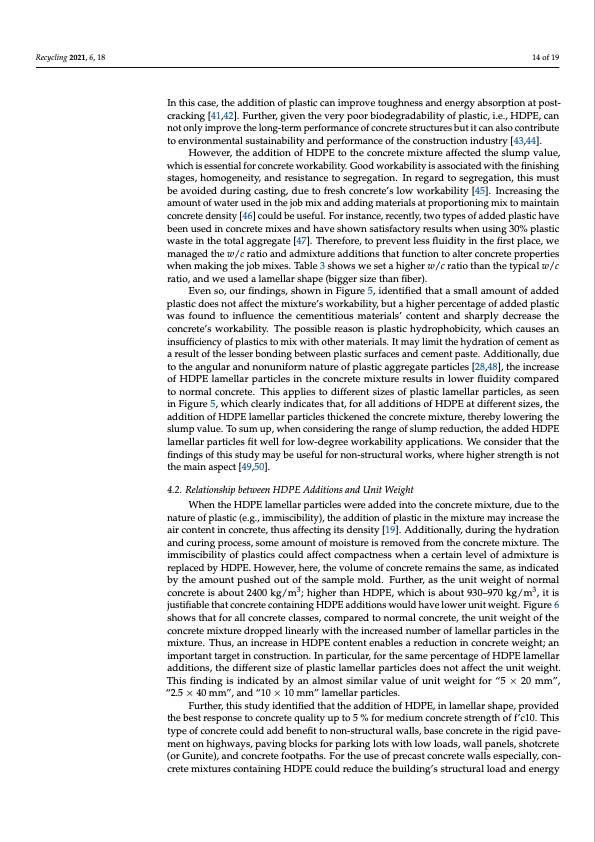
PDF Publication Title:
Text from PDF Page: 014
Recycling 2021, 6, 18 14 of 19 In this case, the addition of plastic can improve toughness and energy absorption at post- cracking [41,42]. Further, given the very poor biodegradability of plastic, i.e., HDPE, can not only improve the long-term performance of concrete structures but it can also contribute to environmental sustainability and performance of the construction industry [43,44]. However, the addition of HDPE to the concrete mixture affected the slump value, which is essential for concrete workability. Good workability is associated with the finishing stages, homogeneity, and resistance to segregation. In regard to segregation, this must be avoided during casting, due to fresh concrete’s low workability [45]. Increasing the amount of water used in the job mix and adding materials at proportioning mix to maintain concrete density [46] could be useful. For instance, recently, two types of added plastic have been used in concrete mixes and have shown satisfactory results when using 30% plastic waste in the total aggregate [47]. Therefore, to prevent less fluidity in the first place, we managed the w/c ratio and admixture additions that function to alter concrete properties when making the job mixes. Table 3 shows we set a higher w/c ratio than the typical w/c ratio, and we used a lamellar shape (bigger size than fiber). Even so, our findings, shown in Figure 5, identified that a small amount of added plastic does not affect the mixture’s workability, but a higher percentage of added plastic was found to influence the cementitious materials’ content and sharply decrease the concrete’s workability. The possible reason is plastic hydrophobicity, which causes an insufficiency of plastics to mix with other materials. It may limit the hydration of cement as a result of the lesser bonding between plastic surfaces and cement paste. Additionally, due to the angular and nonuniform nature of plastic aggregate particles [28,48], the increase of HDPE lamellar particles in the concrete mixture results in lower fluidity compared to normal concrete. This applies to different sizes of plastic lamellar particles, as seen in Figure 5, which clearly indicates that, for all additions of HDPE at different sizes, the addition of HDPE lamellar particles thickened the concrete mixture, thereby lowering the slump value. To sum up, when considering the range of slump reduction, the added HDPE lamellar particles fit well for low-degree workability applications. We consider that the findings of this study may be useful for non-structural works, where higher strength is not the main aspect [49,50]. 4.2. Relationship between HDPE Additions and Unit Weight When the HDPE lamellar particles were added into the concrete mixture, due to the nature of plastic (e.g., immiscibility), the addition of plastic in the mixture may increase the air content in concrete, thus affecting its density [19]. Additionally, during the hydration and curing process, some amount of moisture is removed from the concrete mixture. The immiscibility of plastics could affect compactness when a certain level of admixture is replaced by HDPE. However, here, the volume of concrete remains the same, as indicated by the amount pushed out of the sample mold. Further, as the unit weight of normal concrete is about 2400 kg/m3; higher than HDPE, which is about 930–970 kg/m3, it is justifiable that concrete containing HDPE additions would have lower unit weight. Figure 6 shows that for all concrete classes, compared to normal concrete, the unit weight of the concrete mixture dropped linearly with the increased number of lamellar particles in the mixture. Thus, an increase in HDPE content enables a reduction in concrete weight; an important target in construction. In particular, for the same percentage of HDPE lamellar additions, the different size of plastic lamellar particles does not affect the unit weight. This finding is indicated by an almost similar value of unit weight for “5 × 20 mm”, “2.5 × 40 mm”, and “10 × 10 mm” lamellar particles. Further, this study identified that the addition of HDPE, in lamellar shape, provided the best response to concrete quality up to 5 % for medium concrete strength of f’c10. This type of concrete could add benefit to non-structural walls, base concrete in the rigid pave- ment on highways, paving blocks for parking lots with low loads, wall panels, shotcrete (or Gunite), and concrete footpaths. For the use of precast concrete walls especially, con- crete mixtures containing HDPE could reduce the building’s structural load and energyPDF Image | Recycled HDPE Plastic Additions on Concrete Performance

PDF Search Title:
Recycled HDPE Plastic Additions on Concrete PerformanceOriginal File Name Searched:
recycling-06-00018-v2.pdfDIY PDF Search: Google It | Yahoo | Bing
Development of a solar powered Electric Ship The Electricship website originally started off as a project to develop a comprehensive renewable, affordable, modular electric ship... More Info
Modular Boat Hull Composite The case for a unsinkable, modular composite hybrid boat hull... More Info
MS Burgenstock Hybrid Electric Catamaran Lake Lucerne Unique shuttle servicing Lucerne to the Burgenstock Resort... More Info
Ground Power Unit GPU Powered by Lithium Ion Batteries The goal of the Ground Power Unit is to provide a readily accessible, modular, ready-to-power solution for remote power... More Info
| CONTACT TEL: 608-238-6001 Email: greg@electricship.com | RSS | AMP |